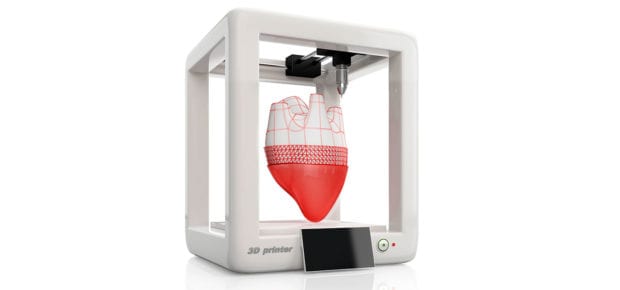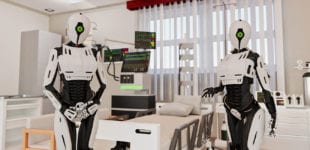October 25, 2019
For patients that suffer from chronic illness or are in critical condition, the time spent waiting for an organ transplant match could mean life or death.In July 2019, over 113,000 United States men, women and children were currently on the national transplant waiting list, according to the Health Resources and Services Administration. Unfortunately, the organ shortage only continues to grow as donor lists stagnate.
The future of 3D organs and bone technologies might have the potential to reduce our need for human transplants all-together. But 3D printing body parts for transplant needs is a relatively new concept in the health and wellness industry, and the truth is, it will take a long time before we become completely dependent on these resources.
Their biggest obstacle? 3D organs and bones use bio-materials that are bio-compatible to an individual. This means surgeons are using a human’s cells to create an ink in the printing process to build a successful implanted organ.
“There is no particular issue in terms of precision since 3D printing, or additive manufacturing, is already being used in other fields, like avionics and printed electronics, and they’re already delivering a product with an accuracy that exceeds the need of organ printing,” says IEEE Senior member Robert Saracco.
Yet, the technology is already being researched, and some 3D printed organs and bones are already being used by health professionals.
See also Tissue Engineering & Regenerative Medicine
How Does 3D Printing Work?
3D printing of organs and bones begins with a number of patient exams and procedures, such as a radiograph and an MRI/TAC, to help a surgeon create a digital model of the implant. “This digital model is then printed using an appropriate combination of materials that are bio-compatible,” says Saracco.
“The process is very similar to the one adopted in additive manufacturing to produce engines or other parts,” notes Saracco. “Some of the materials used may be different, like the use of living cells.This clearly imposes some differences in the way the material is ejected through the printer nozzles and the type of glue used to have the deposited material stick in place.”
3D Organs and Bones Already Being Used
“The very first organs to be 3D printed have actually been 2D organs, more specifically skin,” says Saracco. “This has allowed us to create tailored skin grafts, speeding up the procedure and improving results.”
Saracco also explains that implants are also being used in place of bone and cartilage, such as jaw bones, trachea splinters, hip bones and teeth. In 2018, an Australian woman received the first 3D jaw bone for post-cancer reconstruction, and 3D printing is already revolutionizing dentistry.
“3D printed hip bones is well-established with over 100,000 implants implanted, and we are starting to see partial bone replacement in osteoporosis patients,” says Saracco.
These hard organs and bones are custom-made to fit are not as capable of adapting or changing to the needs of the patient. “They are, and will remain an artifact,” says Saracco.
3D Organs and Bones Currently Being Researched
Unlike the hard 3D printed organs and bones that are currently being used, softer tissues like organs, bladders, hearts and livers are more difficult for engineers and health professionals to replicate. These organs are still in the research stages because 3D soft organs are made with the patient’s cells, and will need to have the ability to replicate and adapt over time.
“The 3D printing has to create a functional scaffolding, imbibe it with the right mix of cells placed in the appropriate places, and ensure the vascularisation,” says Saracco. “The problem in these cases is much more complex and I do not see it likely that a viable solution can become available before the end of the next decade.”
But some 3D scaffolding technology for the trachea will be applied to surgery soon. Saracco explains that there have been several successful trials on animals, and the research plans on moving to human trials.
See also 3D Printing and the Future of Prosthetics
The Benefits of 3D Organs
3D printed organs are sized to fit the patient and the organ is cultivated from the patient’s cells, so there is less chance of the immune system rejecting the transplant. In theory, there is also an unlimited availability of 3D printed organs, and they can be manufactured in a short time. This means there would no longer be a need for a transplant waiting list. Plus, bio-compatibility issues would no longer be an issue for patients with rarer blood types or organs that typically take a longer time to find a match.
3D organs and bones still have a long way to go in terms of research and success rate before we completely ditch the transplant list. But as technology continues to advance, it might not be as far off as we think.





 The Impact of Technology in 2025
The Impact of Technology in 2025 Quantum and AI: Safeguards or Threats to Cybersecurity?
Quantum and AI: Safeguards or Threats to Cybersecurity? Why AI Can't Live Without Us
Why AI Can't Live Without Us Bits, Bytes, Buildings and Bridges: Digital-Driven Infrastructure
Bits, Bytes, Buildings and Bridges: Digital-Driven Infrastructure Impact of Technology in 2024
Impact of Technology in 2024 Emerging AI Cybersecurity Challenges and Solutions
Emerging AI Cybersecurity Challenges and Solutions The Skies are Unlimited
The Skies are Unlimited Smart Cities 2030: How Tech is Reshaping Urbanscapes
Smart Cities 2030: How Tech is Reshaping Urbanscapes Impact of Technology 2023
Impact of Technology 2023 Cybersecurity for Life-Changing Innovations
Cybersecurity for Life-Changing Innovations Smarter Wearables Healthier Life
Smarter Wearables Healthier Life Infrastructure In Motion
Infrastructure In Motion The Impact of Tech in 2022 and Beyond
The Impact of Tech in 2022 and Beyond Cybersecurity, Technology and Protecting Our World
Cybersecurity, Technology and Protecting Our World How Technology Helps us Understand Our Health and Wellness
How Technology Helps us Understand Our Health and Wellness The Resilience of Humanity
The Resilience of Humanity Harnessing and Sustaining our Natural Resources
Harnessing and Sustaining our Natural Resources Creating Healthy Spaces Through Technology
Creating Healthy Spaces Through Technology Exceptional Infrastructure Challenges, Technology and Humanity
Exceptional Infrastructure Challenges, Technology and Humanity The Global Impact of IEEE's 802 Standards
The Global Impact of IEEE's 802 Standards Scenes of our Cyber Lives: The Security Threats and Technology Solutions Protecting Us
Scenes of our Cyber Lives: The Security Threats and Technology Solutions Protecting Us How Millennial Parents are Embracing Health and Wellness Technologies for Their Generation Alpha Kids
How Millennial Parents are Embracing Health and Wellness Technologies for Their Generation Alpha Kids Space Exploration, Technology and Our Lives
Space Exploration, Technology and Our Lives Global Innovation and the Environment
Global Innovation and the Environment How Technology, Privacy and Security are Changing Each Other (And Us)
How Technology, Privacy and Security are Changing Each Other (And Us) Find us in booth 31506, LVCC South Hall 3 and experience the Technology Moon Walk
Find us in booth 31506, LVCC South Hall 3 and experience the Technology Moon Walk Virtual and Mixed Reality
Virtual and Mixed Reality How Robots are Improving our Health
How Robots are Improving our Health IEEE Experts and the Robots They are Teaching
IEEE Experts and the Robots They are Teaching See how millennial parents around the world see AI impacting the lives of their tech-infused offspring
See how millennial parents around the world see AI impacting the lives of their tech-infused offspring Take the journey from farm to table and learn how IoT will help us reach the rising demand for food production
Take the journey from farm to table and learn how IoT will help us reach the rising demand for food production Watch technical experts discuss the latest cyber threats
Watch technical experts discuss the latest cyber threats Explore how researchers, teachers, explorers, healthcare and medical professionals use immersive technologies
Explore how researchers, teachers, explorers, healthcare and medical professionals use immersive technologies Follow the timeline to see how Generation AI will be impacted by technology
Follow the timeline to see how Generation AI will be impacted by technology Learn how your IoT data can be used by experiencing a day in a connected life
Learn how your IoT data can be used by experiencing a day in a connected life Listen to technical experts discuss the biggest security threats today
Listen to technical experts discuss the biggest security threats today See how tech has influenced and evolved with the Games
See how tech has influenced and evolved with the Games Enter our virtual home to explore the IoT (Internet of Things) technologies
Enter our virtual home to explore the IoT (Internet of Things) technologies Explore an interactive map showcasing exciting innovations in robotics
Explore an interactive map showcasing exciting innovations in robotics Interactively explore A.I. in recent Hollywood movies
Interactively explore A.I. in recent Hollywood movies Get immersed in technologies that will improve patients' lives
Get immersed in technologies that will improve patients' lives